
Some of attractions will be covered by the excursion.
A Landscape Blessed by the Sea
After a brief trip upstream along the sparkling waters of the Isuzu River, you can see the Ise Grand Shrine, standing solemnly in the middle of a grove of cedars. The sacred site of Ise has been a destination for travelers since ancient times. Ise is the "starting point for all journeys in Japan," and is regarded as the cradle of Japanese culture. Surrounding Ise the beautiful costal landscapes of Ise-Shima National Park, stretch as far as the can see. A growing number of seaside resorts offer wonderful opportunities to enjoy this marine playground. Ise-Shima ranks as one of Japan's best tourist resort areas, a place where history and natural beauty meet.
 Ise Grand Shrine (Ise-city)
Ise Grand Shrine (Ise-city)
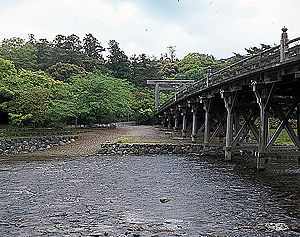 Ise Grand Shrine, with its two-thousand year history, is Japan's most important Shinto shrine and serves as the center of all shrines nationwide. Situated near the banks of the Isuzu River, the shrine is surrounded by 800-year-old Ise Grand Shrine cedars. The smooth pebble-lined approach to the shrine lends the site a majestic air. Ise Grand Shrine consists of the Outer Shrine and Inner Shrine.
The sanctuary of the Inner Shrine is built in the oldest of Japan's sacred architectural styles,"Yuiitsushinmei-zukuri." Amaterasu-Omikami, the Sun Goddess who is enshrined in the Inner Shrine, is considered to be the earliest ancestor of the Japanese Imperial family. Enshrined in the Outer Shrine is Toyouke-no-omikami the guardian deity for the food provided to the Sun Goddess.
Ise Grand Shrine, with its two-thousand year history, is Japan's most important Shinto shrine and serves as the center of all shrines nationwide. Situated near the banks of the Isuzu River, the shrine is surrounded by 800-year-old Ise Grand Shrine cedars. The smooth pebble-lined approach to the shrine lends the site a majestic air. Ise Grand Shrine consists of the Outer Shrine and Inner Shrine.
The sanctuary of the Inner Shrine is built in the oldest of Japan's sacred architectural styles,"Yuiitsushinmei-zukuri." Amaterasu-Omikami, the Sun Goddess who is enshrined in the Inner Shrine, is considered to be the earliest ancestor of the Japanese Imperial family. Enshrined in the Outer Shrine is Toyouke-no-omikami the guardian deity for the food provided to the Sun Goddess.
Outer Shrine (Geku): Five-minute walk from JR or Kintetsu Ise-shi stations. Inner
Shrine (Naiku): Fifteen minutes by bus from JR or Kintetsu Ise-shi stations or from the Kintetsu Uji-Yamada station.
 Okage Yokocho (Ise-city)
Okage Yokocho (Ise-city)
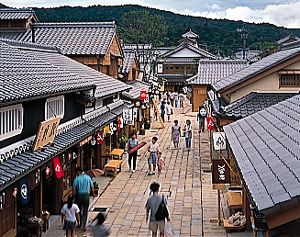 Near the Inner Shrine is a restored section of town which offers a fascinating toste of the atmosphere of Ise piligrimages during the Edo Period(1600-1868). Here you can visit shops and restaurants looking as they appeared long ago, you can also visit the Sangu Rekishikan / Okagae-za museum to learn about the tradition of the Ise pilgrimages.
Near the Inner Shrine is a restored section of town which offers a fascinating toste of the atmosphere of Ise piligrimages during the Edo Period(1600-1868). Here you can visit shops and restaurants looking as they appeared long ago, you can also visit the Sangu Rekishikan / Okagae-za museum to learn about the tradition of the Ise pilgrimages.
Five-minute walk from Ise-Inner Shrine
 Meotoiwa(The Wedded-Rocks) (Futami-city)
Meotoiwa(The Wedded-Rocks) (Futami-city)
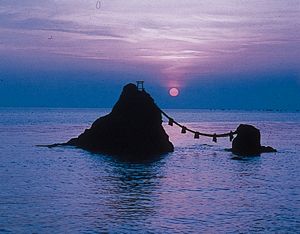 These two large rocks in the sea, fastened together by ropes, have long symbolized marriage in Japan. At the height of summer, the scene of the sun rising between the rocks is spectacular and should not be missed.
These two large rocks in the sea, fastened together by ropes, have long symbolized marriage in Japan. At the height of summer, the scene of the sun rising between the rocks is spectacular and should not be missed.
Fifteen-minute walk from JR Futamigaura station
 Toba Bay and Ago Bay
Toba Bay and Ago Bay
 Toba Bay provides a serene view of three green islands arranged like stepping stones in the blue sea. Beautiful Ago Bay in contrast offers a rugged coastline and floating rafts used for pearl-cultivation. Visitors can take a sightseeing cruise to view the scenery of Ise-Shima National Park at its most spectacular. Lunch and barbecue cruises are also offered.
Toba Bay provides a serene view of three green islands arranged like stepping stones in the blue sea. Beautiful Ago Bay in contrast offers a rugged coastline and floating rafts used for pearl-cultivation. Visitors can take a sightseeing cruise to view the scenery of Ise-Shima National Park at its most spectacular. Lunch and barbecue cruises are also offered.
Toba Bay Cruises: Five-minute walk from JR or Kintetsu Toba stations
Ago Bay Sightseeing Cruises:Five-minute walk from Kintetsu Kashiko-jima station
 Mikimoto Pearl Island (Toba-city)
Mikimoto Pearl Island (Toba-city)
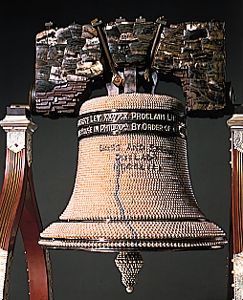 Home of the world-famousMikimoto Pearl, this island is where Kokichi Mikimoto developed the world's first cultured pearls. A museum offers many beautiful pearl products, and various exhibits demonstrate the process of making cultured pearls. Visitors can aIso watch ama, female divers, demonstrate diving for pearls.
Home of the world-famousMikimoto Pearl, this island is where Kokichi Mikimoto developed the world's first cultured pearls. A museum offers many beautiful pearl products, and various exhibits demonstrate the process of making cultured pearls. Visitors can aIso watch ama, female divers, demonstrate diving for pearls.
Five-minute walk from JR or Kintetsu Toba stations
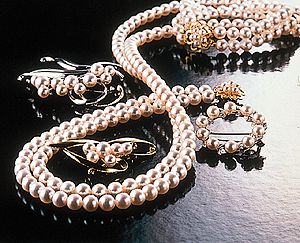 Peals(Toba-city and vicinity)
Peals(Toba-city and vicinity)
Ise-Shima is the birthplace of cultured pearls, and there are many shops selling pearl jewelry in and around Toba. These shops offer many fine examples of this region's distinctive product at reasonable prices.
 Aquariums
Aquariums
Ise-shima has many aquariums.They offer the visitor a close-up view of members of the area's abundant marine life.
Toba Aquarium(Toba-city)
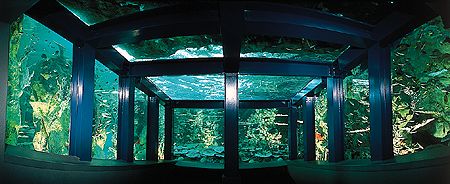 This world-class aquarium is home to over 950 species of 20,000 different sea animals. It is the only aquarium in the world with dugongs.
This world-class aquarium is home to over 950 species of 20,000 different sea animals. It is the only aquarium in the world with dugongs.
Ten-minute walk from JR or Kintetsu Toba stations
Futami Sea Paradise(Futami-town)
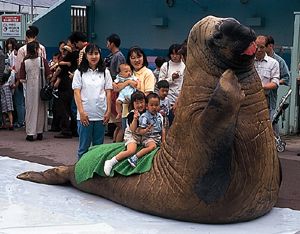 Proximate to Meotoiwa, Futami Sea Paradise features sea lions, walruses and miroungas. Visitors are allowed to photograph and even touch the sea animals.
Proximate to Meotoiwa, Futami Sea Paradise features sea lions, walruses and miroungas. Visitors are allowed to photograph and even touch the sea animals.
Fifteen-minute walk from JR Futami station
Shima Marineland(Ago-town)
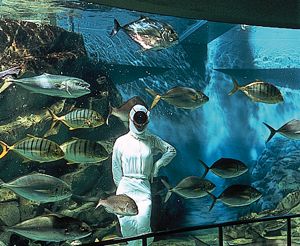 Shima Marineland on Ago Bay offers the visitor close-up views of many interesting fish species, including the manbo fish and electric eel. Ama divers offer a feeding demonstration at the aquarium.
Shima Marineland on Ago Bay offers the visitor close-up views of many interesting fish species, including the manbo fish and electric eel. Ama divers offer a feeding demonstration at the aquarium.
Five-minuite walk from Kintetsu Kashikojima Station
Museum of the Sea(Toba-city)
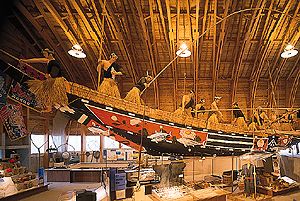 The museum has exhibits organized around seven themes on the relation of the Japanese people and to the sea, including the history of the ama divers and fishing techniques indigenous to the Ise-Shima region. Japanese wooden boats and canoes from around the world are also on display.
The museum has exhibits organized around seven themes on the relation of the Japanese people and to the sea, including the history of the ama divers and fishing techniques indigenous to the Ise-Shima region. Japanese wooden boats and canoes from around the world are also on display.
Take a bus from JR or Kintetsu Toba stations, then a five-minute walk from Umino-Hakubutsukan bus stop.
 Theme Parks
Theme Parks
Ise Sengoku Jidai Mura(Futami-town)
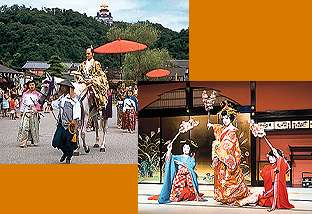 This park brings to life the Sengoku Period (15th-16th centuries), when the power of the samurai was at its height. With a reconstruction of Azuchi Castle as a backdrop, period dramas and ninja action shows are perfomed on the main stage, offering an enjoyable presentation of Japanese history.
This park brings to life the Sengoku Period (15th-16th centuries), when the power of the samurai was at its height. With a reconstruction of Azuchi Castle as a backdrop, period dramas and ninja action shows are perfomed on the main stage, offering an enjoyable presentation of Japanese history.
Take the bus from Kintetsu Uji Yamada station to Ise Sengoku Jidai Mura stop, or fifteen minutes walk from JR Futami station.
Parque Espana-Shima Spain Village(Isobe-town)
 Capturing the calor and charm of Spain, Parque Espana features a fantastic world of elaborate parades and amusing character shows. The park also has the world's fastest suspended roller coaster, the Pyrenees, and many other popular attractions.
Capturing the calor and charm of Spain, Parque Espana features a fantastic world of elaborate parades and amusing character shows. The park also has the world's fastest suspended roller coaster, the Pyrenees, and many other popular attractions.
Take the bus from Kintetsu Shima Isobe station.

 Ise Grand Shrine (Ise-city)
Ise Grand Shrine (Ise-city) Ise Grand Shrine, with its two-thousand year history, is Japan's most important Shinto shrine and serves as the center of all shrines nationwide. Situated near the banks of the Isuzu River, the shrine is surrounded by 800-year-old Ise Grand Shrine cedars. The smooth pebble-lined approach to the shrine lends the site a majestic air. Ise Grand Shrine consists of the Outer Shrine and Inner Shrine.
The sanctuary of the Inner Shrine is built in the oldest of Japan's sacred architectural styles,"Yuiitsushinmei-zukuri." Amaterasu-Omikami, the Sun Goddess who is enshrined in the Inner Shrine, is considered to be the earliest ancestor of the Japanese Imperial family. Enshrined in the Outer Shrine is Toyouke-no-omikami the guardian deity for the food provided to the Sun Goddess.
Ise Grand Shrine, with its two-thousand year history, is Japan's most important Shinto shrine and serves as the center of all shrines nationwide. Situated near the banks of the Isuzu River, the shrine is surrounded by 800-year-old Ise Grand Shrine cedars. The smooth pebble-lined approach to the shrine lends the site a majestic air. Ise Grand Shrine consists of the Outer Shrine and Inner Shrine.
The sanctuary of the Inner Shrine is built in the oldest of Japan's sacred architectural styles,"Yuiitsushinmei-zukuri." Amaterasu-Omikami, the Sun Goddess who is enshrined in the Inner Shrine, is considered to be the earliest ancestor of the Japanese Imperial family. Enshrined in the Outer Shrine is Toyouke-no-omikami the guardian deity for the food provided to the Sun Goddess.
 Okage Yokocho (Ise-city)
Okage Yokocho (Ise-city) Near the Inner Shrine is a restored section of town which offers a fascinating toste of the atmosphere of Ise piligrimages during the Edo Period(1600-1868). Here you can visit shops and restaurants looking as they appeared long ago, you can also visit the Sangu Rekishikan / Okagae-za museum to learn about the tradition of the Ise pilgrimages.
Near the Inner Shrine is a restored section of town which offers a fascinating toste of the atmosphere of Ise piligrimages during the Edo Period(1600-1868). Here you can visit shops and restaurants looking as they appeared long ago, you can also visit the Sangu Rekishikan / Okagae-za museum to learn about the tradition of the Ise pilgrimages.
 Meotoiwa(The Wedded-Rocks) (Futami-city)
Meotoiwa(The Wedded-Rocks) (Futami-city) These two large rocks in the sea, fastened together by ropes, have long symbolized marriage in Japan. At the height of summer, the scene of the sun rising between the rocks is spectacular and should not be missed.
These two large rocks in the sea, fastened together by ropes, have long symbolized marriage in Japan. At the height of summer, the scene of the sun rising between the rocks is spectacular and should not be missed.  Toba Bay and Ago Bay
Toba Bay and Ago Bay Toba Bay provides a serene view of three green islands arranged like stepping stones in the blue sea. Beautiful Ago Bay in contrast offers a rugged coastline and floating rafts used for pearl-cultivation. Visitors can take a sightseeing cruise to view the scenery of Ise-Shima National Park at its most spectacular. Lunch and barbecue cruises are also offered.
Toba Bay provides a serene view of three green islands arranged like stepping stones in the blue sea. Beautiful Ago Bay in contrast offers a rugged coastline and floating rafts used for pearl-cultivation. Visitors can take a sightseeing cruise to view the scenery of Ise-Shima National Park at its most spectacular. Lunch and barbecue cruises are also offered.
 Mikimoto Pearl Island (Toba-city)
Mikimoto Pearl Island (Toba-city) Home of the world-famousMikimoto Pearl, this island is where Kokichi Mikimoto developed the world's first cultured pearls. A museum offers many beautiful pearl products, and various exhibits demonstrate the process of making cultured pearls. Visitors can aIso watch ama, female divers, demonstrate diving for pearls.
Home of the world-famousMikimoto Pearl, this island is where Kokichi Mikimoto developed the world's first cultured pearls. A museum offers many beautiful pearl products, and various exhibits demonstrate the process of making cultured pearls. Visitors can aIso watch ama, female divers, demonstrate diving for pearls.
 Peals(Toba-city and vicinity)
Peals(Toba-city and vicinity) Aquariums
Aquariums This world-class aquarium is home to over 950 species of 20,000 different sea animals. It is the only aquarium in the world with dugongs.
This world-class aquarium is home to over 950 species of 20,000 different sea animals. It is the only aquarium in the world with dugongs.
 Proximate to Meotoiwa, Futami Sea Paradise features sea lions, walruses and miroungas. Visitors are allowed to photograph and even touch the sea animals.
Proximate to Meotoiwa, Futami Sea Paradise features sea lions, walruses and miroungas. Visitors are allowed to photograph and even touch the sea animals.
 Shima Marineland on Ago Bay offers the visitor close-up views of many interesting fish species, including the manbo fish and electric eel. Ama divers offer a feeding demonstration at the aquarium.
Shima Marineland on Ago Bay offers the visitor close-up views of many interesting fish species, including the manbo fish and electric eel. Ama divers offer a feeding demonstration at the aquarium.
 The museum has exhibits organized around seven themes on the relation of the Japanese people and to the sea, including the history of the ama divers and fishing techniques indigenous to the Ise-Shima region. Japanese wooden boats and canoes from around the world are also on display.
The museum has exhibits organized around seven themes on the relation of the Japanese people and to the sea, including the history of the ama divers and fishing techniques indigenous to the Ise-Shima region. Japanese wooden boats and canoes from around the world are also on display.
 Theme Parks
Theme Parks This park brings to life the Sengoku Period (15th-16th centuries), when the power of the samurai was at its height. With a reconstruction of Azuchi Castle as a backdrop, period dramas and ninja action shows are perfomed on the main stage, offering an enjoyable presentation of Japanese history.
This park brings to life the Sengoku Period (15th-16th centuries), when the power of the samurai was at its height. With a reconstruction of Azuchi Castle as a backdrop, period dramas and ninja action shows are perfomed on the main stage, offering an enjoyable presentation of Japanese history.
 Capturing the calor and charm of Spain, Parque Espana features a fantastic world of elaborate parades and amusing character shows. The park also has the world's fastest suspended roller coaster, the Pyrenees, and many other popular attractions.
Capturing the calor and charm of Spain, Parque Espana features a fantastic world of elaborate parades and amusing character shows. The park also has the world's fastest suspended roller coaster, the Pyrenees, and many other popular attractions.